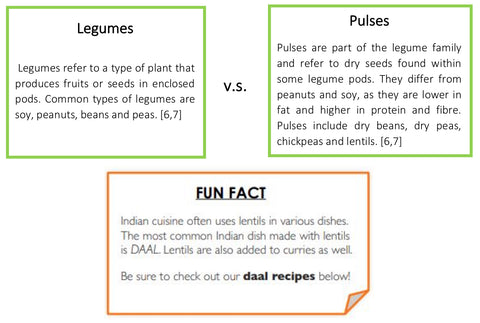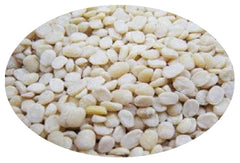Legumes, lentils and pulses. What's the difference?


What are Lentils?
Lentils are considered pulses (the edible seed from legume pods) that are easy to prepare, inexpensive and provide many nutrients such as protein, fibre, vitamin and minerals. Lentils come in many varieties that differ in colour, texture, taste, and uses. They are also commonly sold in grocery stores, where they can be found in whole or split form, and packaged as dried or canned.
Unlike other legumes, lentils do not require overnight soaking. Cook times range from 10-45 minutes, making it an ideal ingredient for quick dishes. Lentils are also perfect for vegetarian and vegan meals, and can be easily used as a substitute for meat.

Varieties
Brown Lentils

Brown lentils are the most commonly used type of lentil. They have a mild, earthy taste and a creamy texture. These lentils maintain their shape while cooking and are often used in warm salads, soups and stews. They can also be used to make vegetarian versions of meat-like dishes such as burgers and meatloaf. [1-2,4]
Green Lentils

Green lentils are also often used and appear very similar to brown lentils, but are larger in size and contain a slight peppery flavour. They remain firm when cooking and are used in salads and side dishes. [1-2,4]
Red Lentils

Red lentils can include a variety of colours ranging from red to orange and yellow. These lentils are often sold in “split” form and contain a slight sweet and nutty flavour. As red lentils lose their shape upon cooking, they help to thicken dishes and are used in soups and stews as well as Indian daals and Middle Eastern cuisine. [1-2,4]
Check out our Daal Masoor recipe that uses red lentils.
Black (Beluga) Lentils

Beluga lentils are tiny, black lentils that become shiny when cooked. They consist of a rich, earthy flavour and soft texture. Since they retain their shape when cooked and contrast most foods, they are added to pasta, rice and vegetables. [1-2,4]
Try our Mahn Di Daal recipe that uses black lentils.
Urad Lentils

Urad Lentils are dehulled (skinned) black lentils. They are pale yellow on the inside and contain a mild, earthy flavour. When cooked, these lentils become soft and glutinous. We have a recipe for this as well - check out our Suki Mahn Daal recipe.

Benefits of Lentils
All lentils provide many benefits that can be attributed to their protein, fibre and vitamin contents.
- Fibre: Lentils are rich in soluble fibre, which reduce blood sugar and cholesterol levels. This helps to control or prevent heart disease and diabetes. Their fibre content also aids in digestion and preventing constipation. [3,4]
- Protein: Lentils contain high levels of protein that provide satiety and fullness. Protein also helps the body to build and repair tissues. [4]
Vitamins and Minerals
- Iron: Lentils are rich in iron and can boost energy levels by replenishing iron stores. Iron also helps with transporting oxygen throughout the body, which is important for energy production and metabolism. [3,4]
DID YOU KNOW?
Various components within our bodies require nutrients to function optimally. As most foods are unable to provide us with complete nutritional requirements when eaten alone, combining certain foods can offer additional nutrients and health benefits. Below is one of many food combinations. [8,9]
Complementary Protein
The human body uses a total of 20 amino acids to make protein, 10 of which are known as “essential amino acids”. These amino acids are regarded as essential because our bodies are unable to make them, which mean they are only available to us through consuming foods. [8,9]
Our daily energy intake should consist of 10-35% protein. Animal-based sources of protein provide us with complete protein. However, plant-based protein such as beans, peas, lentils and grains contain incomplete amino acids and must be combined with other complementary food in order to provide all amino acids and complete protein. For example, pairing lentils with a grain like rice, offers complete protein. [8,9]
Combinations of Complementary Protein:
- Legumes or pulses with grains
- Legumes or pulses with nuts or seeds
- Legumes or pulses with diary
- Grain foods with dairy products

References
- Comprehensive Guide to Lentils. (2018, January 17). Retrieved from https://ohmyveggies.com/a- comprehensiveguide-to-lentils/
- Gavin, J. (2018, January 19). What Are Lentils? Nutrition and Varieties. Retrieved from https://www.jessicagavin.com/what-are-lentils/
- Lentils. (n.d.). Retrieved from http://www.whfoods.com/genpage.php?tname=foodspice&dbid=52
- Morin, K. (2016, February 23). Everything You Need to Know About Lentils. Retrieved from https://www.fix.com/blog/everything-you-need-to-know-about-lentils/
- Nutrient Profile - Lentils. (n.d.). Retrieved from https://food-nutrition.canada.ca/cnf-fce/report-rapport.do
- What are Pulses & Legumes. (n.d.). Retrieved from https://www.doctorsbeyondmedicine.com/listing/what- arepulses-legumes
- What are Pulses | Half-Cup Habit. (n.d.). Retrieved from https://pulses.org/nap/what-are-pulses/
- Asnutrition. (2017, October 25). Protein Complementation. Retrieved from https://nutrition.org/proteincomplementation/
- Complementary proteins and how they work. (2017, March 29). Retrieved from https://sunshinecoastdietetics.com.au/complementary-proteins-and-how-they-work/
Also in Blog

Top 5 Low Carb Barbecue (BBQ) Recipes on SwitchGrocery
We are so excited to announce that our spice blends and drink mixes: Tandoori Masala, Tadka Masala, Garam Masala, Raita Salt and Chai Masala are now available to purchase from SwitchGrocery! To celebrate our partnership, SwitchGrocery has featured 5 amazing low carb recipes WITH MACROS that you can make using our spices with meat from truLOCAL, an online local meat delivery company!

This 10-Minute Recipe Will Help You Lose Weight

An easy way to cut out over 100 calories per meal, is to stop eating processed condiments or sauces, like ketchup, ranch dressing or plum sauce. These sauces are high in calories, sugar and/or fat. They also contain lots of unnatural ingredients. A healthier way to add tons of flavour to a meal is to make homemade Indian Mint Chutney and keep it in your fridge of freezer. Traditionally, mint chutney is eaten with Indian appetizers like samosas or pakoras, or with any Indian main dish like aloo gobi or daal. But you can experiment and eat it with grilled meats or tofu or even use it as a spread on a sandwich. It will make any bland meal way more delicious and it's really easy to make.


